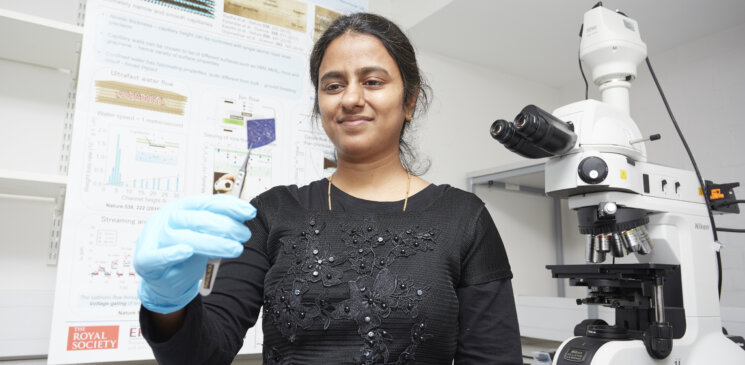
Radha Boya is a Professor of Nanoscience at the University of Manchester, and a Royal Society University Research fellow in the department of Physics, National Graphene Institute.
Tell us more about your role at the University of Manchester.
I am a Professor of Nanoscience and Royal Society University Research fellow in the department of Physics, National Graphene Institute and affiliated to Photon Science Institute.
I conduct research on atomic scale capillaries, mentor students and researchers, teach undergraduate and postgraduate students.
I lead a research group with excellent researchers, postdoctoral associates and PhD students. We collaborate with national and international research groups on the frontier topic of atomic scale capillaries measurements.
What do you enjoy most about working in your sector?
It’s incredibly rewarding to engage in research that pushes the boundaries of knowledge and to collaborate with talented colleagues and students who share a passion for discovery.
Additionally, it is fulfilling to mentor the next generation of scientists and witness their growth and contributions to the field.
How important is innovation within your role/sector?
Whether it is about making new experimental systems like atomic scale capillaries, or new understandings of phenomena that are widely important for practical applications, innovation drives all breakthroughs and progress in the scientific field.
What professional achievement are you most proud of?
I am happy to have contributed to the development of one atom to few atom thin capillaries.
These serve as a platform to confine water, and ions which is not only important for understanding filtration selectivities of ions from water, but also lead to new emergent properties such as neuromorphic ionic memory. The brain uses ions, chemicals and water to make its calculations and store information, ‘memory’, whereas artificial computers use electrons in their operation.
The emerging field of nanofluidic computing, also called ionic computing, raises the possibility of devices that operate similarly to the human brain. It represents a culmination of years of research, collaboration, and innovation.
What, if any, are the challenges of being a woman working in your sector?
Many women drop out as we go to higher studies. Even after doing a PhD in STEM, many women do not continue to be in science. In a career like science, which needs consistent commitment of both time and hard work, women need a support system both at home and in institutions.
What advice would you give to other women working in your sector?
Even though there are less women pursuing a career in science or in the HE/University level education than we’d like, the number of great women scientists gives a clear indication that this is a career where passions can be fulfilled and professional goals realised.
Mentorship is essential for anyone in science, but especially for women. I have been fortunate to have good mentors all through my career. Hard work and perseverance are quite important for research in addition to the need for creativity and smartness.
We are only limited by the limitations that we create for ourselves. I admire Marie Skłodowska-Curie as a scientist, and like one of her quotes especially.
“A scientist in his laboratory is not a mere technician: she/he is also a child confronting natural phenomena that impress her/him as though they were fairy tales”
Can you please tell us more about your work with with atomic scale nanocapillaries and the wider impact this could have?
I am working with atomic scale capillaries, my research group is exploring fundamental phenomena in nano and angstrofluidics. These capillaries are tiny rectangular pipes and can be viewed as if individual atomic planes were removed from a bulk two-dimensional (2D) crystal leaving behind flat voids of a chosen height.
To give an estimate of the size of the pipe, I give an example. If we take human hair (1/100000 of a meter, i.e., micrometer in size), and slice it into 1000 times, the size is one-billionth of a meter and that’s the size of the pipes that we are making.
These pipes are a result of absence of graphene in a layered crystal, created by extracting one-atomic layer out of crystal, hence can be called as 2D empty space. This is a completely new type of nanoscale system, which can be made as a cavity (to confine various substances) or an open-ended tunnel (for transporting matter).
Membrane-based applications with nanoscale channels, such as osmotic power generation, desalination, and molecular separation would benefit from understanding the mechanisms of ion sieving, ways to decrease fluidic friction, and increasing the overall efficiency of the process. However, mechanisms that allow fast flows are not fully understood yet. With the capillaries that are only few atoms thick, we investigate fundamental sieving mechanisms behind important applications such as filtration, separation of ions, molecules and gases, desalination, which are quite important and essential for the world’s progress.